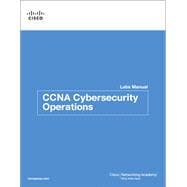The only authorized Lab Manual for the Cisco Networking Academy CCNA Cybersecurity Operations course Curriculum Objectives
CCNA Cybersecurity Operations 1.0 covers knowledge and skills needed to successfully handle the tasks, duties, and responsibilities of an associate-level Security Analyst working in a Security Operations Center (SOC).
Upon completion of the CCNA Cybersecurity Operations 1.0 course, students will be able to perform the following tasks:
- Install virtual machines to create a safe environment for implementing and analyzing cybersecurity threat events.
- Explain the role of the Cybersecurity Operations Analyst in the enterprise.
- Explain the Windows Operating System features and characteristics needed to support cybersecurity analyses.
- Explain the features and characteristics of the Linux Operating System.
- Analyze the operation of network protocols and services.
- Explain the operation of the network infrastructure.
- Classify the various types of network attacks.
- Use network monitoring tools to identify attacks against network protocols and services.
- Use various methods to prevent malicious access to computer networks, hosts, and data.
- Explain the impacts of cryptography on network security monitoring.
- Explain how to investigate endpoint vulnerabilities and attacks.
- Analyze network intrusion data to verify potential exploits.
- Apply incident response models to manage network security incidents.








